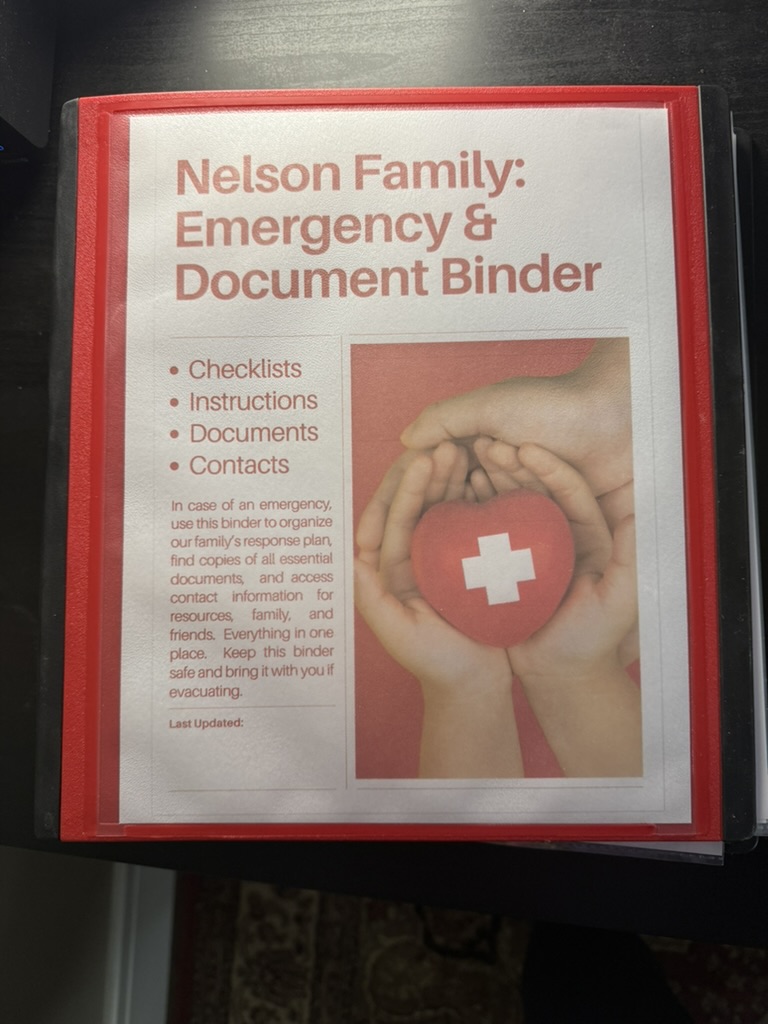
What Should Be in Your Emergency Red Binder?
Here’s a checklist of documents and items to include in your Red Binder:
- Family Emergency Plan:
- Evacuation Checklists
- Emergency escape plan, and meeting place for the family to reunite.
- Maps
- Emergency Contacts (including family, close friends, doctors, insurance agents, and financial advisors)
- List of emergency services (FEMA, Red Cross, Local Shelters)
- Personal Identification:
- Copies of birth certificates, marriage certificates, social security cards, driver’s licenses, and passports, adoption papers.
- Medical records for each family member, including allergies, medications, and past surgeries.
- Emergency contact information, including neighbors, doctors, and family members.
- Insurance Information:
- Homeowner’s or renter’s insurance details.
- Car insurance documents.
- Health insurance cards and contact information.
- Life insurance policies.
- Legal Documents:
- Copies of Wills, trusts, power of attorney, and guardianship documents.
- Marriage certificates and divorce decrees (if applicable).
- Property deeds and mortgage documents.
- Financial Records:
- Bank account numbers, credit card information, and any investments.
- Tax returns for the past 3-5 years.
- Investment portfolios and retirement account details.
- Copy of home deed or rental agreement
- Copy of vehicle titles and registrations
- Utility account information (electricity, water, gas, internet)
- Emergency Cash ($200 – $500 in small bills)
- Medical and Health Information:
- Prescriptions and over-the-counter medication lists.
- Copies of healthcare cards and plans.
- Medical power of attorney, advanced healthcare directives, and emergency medical instructions.
- Other Important Information:
- Pet care instructions (if you have pets, include feeding schedules, medications, and vet contacts).
- Household inventory (keep a list of your valuables for insurance purposes).
- Photos & Sentimental Items
- List of critical passwords
Where Should You Store Your Emergency Red Binder?
It’s crucial to store your Red Binder in a place that is both secure and accessible. Here are some tips for keeping it safe but ready:
- High and Dry: Store your Red Binder in a fireproof and waterproof safe. This will protect the contents from fire, water damage, and theft.
- Easily Accessible: Keep it in a place where you can quickly grab it during an evacuation—preferably near the door or in an easy-to-reach location.
- Back-Up Copies: Consider storing digital copies of the most important documents in a secure online folder or on an encrypted USB drive, so you have a backup in case the physical binder is lost or damaged.
Customizable Evacuation Checklist
Before you leave your home in an emergency, make sure you have the following essentials. Use this checklist to customize your own evacuation plan:
- ☐ Personal Identification (passports, IDs, social security cards)
- ☐ First Aid Kit
- ☐ Prescriptions and medications (a week’s worth)
- ☐ Cell phone and charger (or portable charger)
- ☐ Cash (in case ATMs are down)
- ☐ Important documents (e.g., birth certificates, insurance policies)
- ☐ Food and water (enough for at least 72 hours)
- ☐ Flashlights and extra batteries
- ☐ Emergency contact information (written down, not just in your phone)
- ☐ Pet supplies (if applicable)
- ☐ Clothing (for all family members, including sturdy shoes)
- ☐ Keys (house, car, and safe deposit box)
Pro Tip: Keep a go-to bag with your Red Binder that contains some of these essential items. This will ensure that you are always ready to evacuate in a hurry. To get some ideas of what to include in your go-to bag see my post here.
Prepare Today for the Unseen Things of Tomorrow
Emergencies come without warning, and often, when you least expect it. But being prepared can make a world of difference. By taking action today and creating your Emergency Red Binder as well as building up your home food supply, you’re giving yourself and your family the tools to handle whatever comes tomorrow. Use this food storage calculator to help you in your food storage preparations.
Don’t wait for the unexpected. Prepare for it now, so that in an emergency, you have peace of mind knowing you’ve done everything you can to protect what matters most.
Final Thoughts
Having an Emergency Red Binder is more than just a precaution—it’s a proactive step in securing your family’s future. The process of putting it together will also help you feel more organized and confident about handling any emergency situation.
Prepare today for the unseen things of tomorrow. Take action now to protect your family, your home, and your future.